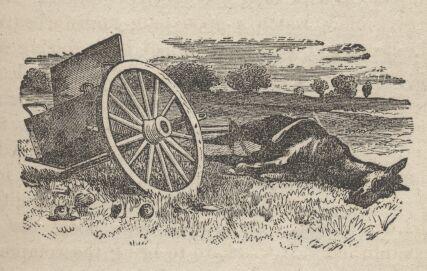Located across the Carson River from what was to be the future site of Fort Churchill, Buckland’s Station consisting of a log cabin and saloon was established by Samuel S. Buckland who had come to California in 1850 via the Isthmus of Panama. During the cold winter of 1859-60, Buckland constructed a toll bridge across the Carson River, and set the following fees for its use: $2.00 for heavy wagons, $1.50 for light wagons, $1.00 for buggies, and $.25 for pedestrians.
A bridge across the river, supplies for sale, extra livestock to replace trail-weary animals, and a good supply of gut-warming whiskey made Buckland’s Station a natural stopping place for men who had crossed the Great Basin, or who were headed into the desert wilderness.
In March of 1860, Bolivar Roberts made arrangements with Samuel Sanford Buckland to use his “good-sized cabin” as a station. Apparently the rancher declined employment as keeper, for this position was taken by W.C. Marley. The place served as a rider-relay, or home station, until the establishment of Fort Churchill in the summer of 1860.
Prior to the establishment of the fort, several memorable events took place at Buckland’s Station including Johnson Richardson’s refusal to relieve Bob Haslarn forcing the latter to make his famous ride. “Pony Bob” Haslam, one of the most famous riders of the Pony Express, rode regularly from Lake Tahoe to Buckland’s Station near Fort Churchill. Perhaps his greatest ride, 120 miles in 8 hours and 20 minutes while wounded, was an important contribution to the fastest trip ever made by the Pony Express — the message carried, Lincoln’s Inaugural Address.
On May 11, 1860 men on their way to battle at Pyramid Lake stayed at Buckland’s. They took Pony Express horses with them, and four days later, the survivors of the battle straggled back to Buckland’s. By the end of the summer of 1860, Indian troubles had forced the establishment of Fort Churchill. From then until the end of the Pony Express, the headquarters building at the fort was used as a stopping station instead of Buckland’s. Today the original log cabin used by the Pony Express is gone,but a house built later marks the spot. It is located 8½ miles south of Silver Springs on US 95 Alternate.
A number of sources identify Buckland's as a station. Townley and the Bureau of Land Management suggest that Buckland's Station functioned as a home station. In 1859, Samuel S. Buckland established a log ranch and trading post and he made an agreement with Bolivar Roberts in March 1860 for his ranch to serve as a Pony Express home station. In the summer of 1860, due to the Pyramid Lake Indian War, soldiers established Fort Churchill a few miles west of Buckland's Station. The Pony Express then moved its station to the fort's protective headquarters. On October 19, 1860, when Richard Burton visited Buckland's, he described the station, as usual, in negative terms.
The station's original log cabin no longer remains. By 1979, a house stood on the station site, eight and one-half miles south of Silver Springs, on Alternate Highway 95.
Hurrah again in 19th October
This day will be the last of my diary. We have now emerged from the deserts of the Basin State, and are debouching upon lands where coaches and the electric telegraph ply.
After a cold night at the hospitable Smith's, and losing the cattle, we managed to hitch to, and crossed, not without difficulty the deep bed of the Carson River, which runs over sands glittering with mica. A little beyond it we found the station house, and congratulated ourselves that we had escaped a twelve hours' durance vile in its atmosphere of rum, korn schnapps, stale tobacco, flies, and profane oaths, not to mention the chance of being wiped out in a difference between a soldier and a gambler, or a miner and a rider.
From the station house we walked, accompanied by a Mr 0, - who, after being an editor in Texas, had become a mail rider in Utah Territory, - to the fort. It was, upon the principle of its eastern neighbors, a well-disposed cantonment, containing quarters for the officers and barracks for the men. Fort Churchill had been built during the last few months: it lodged about two companies of infantry, and required at least 2,000 men. Captain F. F. Flint (6th Regiment) was then commanding, and Lieutenant Colonel Thomas Swords, a deputy quarter master general, was on a tour of inspection. We went straight to the quarter master's office, and there found Lieutenant Moore, who introduced us to all present, and supplied us with the last newspapers and news. The camp was Teetotalist, and avoided cards like good Moslems: we were not, however, expected to drink water except in the form of strong waters, and the desert had disinclined us to abstain from whisky. Finally, Mr Byrne, the sutler, put into our ambulance a substantial lunch, with a bottle of cocktail, and another of cognac, especially intended to keep the cold out.
(The City of the Saints, p 494-5)
